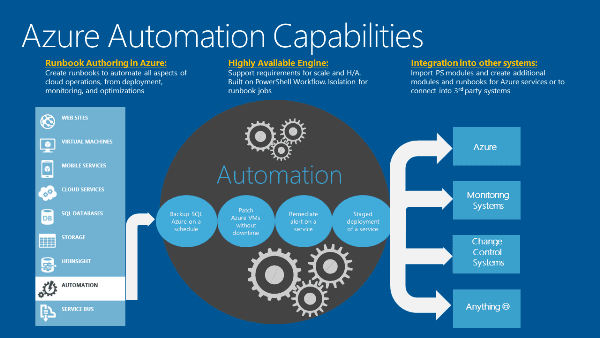- Home
- Blog
- Microsoft Azure
- Azure Automation - Benefits and Special Features

- Azure Active Directory
- Azure Active Directory B2C
- Azure Active Directory Domain Services
- Azure Analysis Services
- Azure App Services
- What is Azure Application Insights?
- Azure Arc
- A Complete Guide On Microsoft Azure Batch
- Azure Cognitive Services
- Azure Data Catalog
- Azure Data Factory - Data Processing Services
- Microsoft Azure Data Factory Tutorial (2024)
- Everything You Need To Know About Azure Data Lake
- Azure DNS - Azure Domain Name System
- Azure ExpressRoute
- Azure Functions - Serverless Compute
- Azure Interview Questions and Answers (2024)
- Azure IoT Edge Overview
- Azure IoT Hub
- What Is Azure Key Vault??
- Azure Load Balancer
- Azure Logic Apps - The Lego Bricks to Serverless Architecture
- Azure Machine Learning
- Microsoft Azure Media Services
- Azure Monitor
- Introduction To Azure SaaS
- Azure Security Center
- Azure Service Bus
- Overview of Azure Service Fabric
- Azure Site Recovery
- Azure SQL Data Warehouse
- Azure Stack - Cloud Services
- Azure Stream Analytics
- Azure Virtual Machine
- Azure’s Public Cloud
- Microsoft Azure Application Gateway
- Microsoft Azure Certification Path
- Microsoft Azure - Exactly What You Are Looking For!
- Microsoft Azure Fabric Interview Questions
- HDInsight Of Azure
- IS Microsoft Azure Help To Grow?
- Microsoft Azure Portal
- Microsoft Azure Traffic Manager
- Microsoft Azure Tutorial
- Overview of Azure Logic Apps
- Top 10 Reasons Why You Should Learn Azure And Get Certified
- Server-Less Architecture In Azure
- What is Microsoft Azure
- Why Azure Machine Learning?
- Azure DevOps Interview Questions
- Azure Active Directory Interview Questions
- Azure DevOps vs Jira
- What is Azure Service Fabric
- What is Azure Databricks?
- Azure Databricks Interview Questions
- Azure Data Factory Interview Questions
- Azure Architect Interview Questions
- Azure Administrator Interview Questions
- Azure Data Studio vs SSMS
- Microsoft Interview Questions
- What is Azure Data Studio - How to Install Azure Data Studio?
- Azure DevOps Projects and Use Cases
- Azure Data Factory (ADF) Integration Runtime
- Azure DevOps Delivery Plans
- Azure DevOps Variables
- Azure DevOps vs GitHub
- Azure DevOps Pipeline
Automation is the technique of using machines to perform a task that was earlier performed by humans. Automating a task or process which is repeated frequently helps reduce human intervention. It helps increase output, lower operating costs, and improve ROI.
What is Azure Automation?
Azure Automation is a cost-effective cloud-based automation platform. It provides an expansive automation service that enables you to automate tasks that would otherwise take up an IT personnel’s valuable time.
Based on and built using PowerShell Workflow, it is compatible with multiple vendors, cloud platforms, and on-premise systems. Azure Automation can also be configured to interact and automate On-Premise infrastructure. The component that enables this feature is called an Azure Hybrid Runbook Worker.
What is Azure Runbook?
A runbook typically is a compilation of routine IT procedures and operations required by administrators. Azure Runbooks run on the Azure cloud platform but do not have access to on-premises resources. The Hybrid Runbook Worker feature of Azure Automation allows you to run Runbooks directly on the computer hosting the role. The Hybrid Runbooks interact with local resources in the environment and are stored and managed in Azure Automation. They are delivered to one or more designated Hybrid Worker computers over VPN in a cloud environment or over the internet in On-Premise devices.
If you would like to become a Microsoft Azure certified professional, then visit Mindmajix - A Global online training platform “Azure Certification Training” This course will help you to achieve excellence in this domain.
How Azure Automation Works For An Enterprise?

Azure Automation Tools virtualize the infrastructure of the Enterprise. Allowing them to streamline their IT-related workloads, reduce manual attention, automate backups, and recovery systems. The most important function is adjusting scalability according to the usage. Adjusting the environment during holidays to the reduced workload is one of the simplest Azure Automation examples.
What Are The Benefits Of Azure Automation?
Azure Automation Service simplifies cloud management and automation by optimizing your existing investment and skills of integration. Some of the benefits of Azure Automation are:
Lowers costs: Your routine and time-consuming cloud management tasks are often error-prone. Azure Automation helps reduce errors and increase efficiency along with Windows Azure to help you reduce operational costs and save time.
Optimizes workflows: Azure automation allows you to leverage the existing workflows or customize them to design your own workflows. You can monitor and maintain Azure resources and also create and deploy your own runbooks, as needed. Going through a few Azure Automation Tutorials you can easily create different types of runbooks including Graphical, PowerShell, and Python.
Integration: Azure Automation works seamlessly with websites, VMs, servers, storage, and other Azure services. It can also be used with any third-party applications, service offerings, or public internet APIs.
Reliable service: Azure efficiently handles systems, tools, and departments improving your performance and saving time.
What Is The Special Feature Of Azure Automation?
Microsoft Azure Automation has been developed as a simple and speedy cloud platform. It comes packed with significant features such as:
- It Integrates with other systems or existing systems by building PowerShell integration modules.
- It accelerates the flexible workflow process.
- It improves reliability in service among different tools, systems, and departments.
- It reduces manual activities in detecting errors & corrections.
In addition to the above Azure Automation features, the service also offers:
- Runbooks are the special feature of Azure Automation. It helps in automating those tasks that are time-consuming, requires time to run and execute, and has possibilities of getting frequent errors.
- Graphical Authoring is another special feature of Azure Automation that allows you to add activities from the library that are already there in runbooks and link them to form a workflow. One does not need to write any complex PowerShell scripts.
Microsoft Azure Interview Questions
Why Azure Automation Is Important?
Manual Errors and Manual Dependency Is Reduced :
Azure Automation technology is used by enterprises that have multiple organizational setups in different countries. They require a huge network, along with regular hardware and software maintenance. Therefore, these organizations need to recruit professionals to take care of their systems continuously and manually. This adds to the chances of human errors and other problems arising from manual dependency. Automation cuts down the requirement to recruit humans for the process. So, instead of hiring 100 testers for maintenance projects, they can hire 45-50 testers to just look into alerts. This is making organizations spend less on manpower.
Information Is More Secured and Holistic :
The process, reports, and information/data are secured through automatic backup and recovery methods. So, in case of an unforeseen disaster, the data can be easily retrieved. Role-based access ensures information is under the control of someone trustworthy.
A virtual machine is automatically built to act as a maintenance window for the main system. It gives alerts for restart and update on an hourly, weekly, monthly, and yearly basis for maintenance.
Automated Patching of Virtual Machine :
Azure Virtual machines can provide high availability of data along with with self- healing ( auto- service), failure- alert systems, Geo-replication and high availability of data with disaster recovery mechanisms.
But, It Has Some Limitations
- Geo-replication systems do not support data and log files in multiple storage disks are the main limitation of Azure Automation.
Geo-replication system is a concept designed to improve data across distributed networks. But, if we configure a database in Azure Storage Disk, during the recovery process, if we want the data file and log files it limits us from the write-ahead log in SQL thus violating ACID properties of SQL.
Also Read : Why Azure Machine Learning?
- It protects Virtual Machine but not SQL running inside the Virtual Machine. It Manages Configuration Changes Between The Systems.
- You can change the system configurations from Windows to Linux. It allows multiple users to access and is a software-as-a-service( SAS) that provide scalable and reliable automation process for all your IT related operations in an organization.
What are Other Automation Tools Similar To Azure Automation?
Service Management Automation (SMA) is another automation tool similar to Azure but SMA does not have graphical runbooks. System Center 2012 Orchestrator is mainly for the automation of on-premises resources.
Conclusion:
Azure Automation is a software-as-a-service (SAS) that provides a scalable and reliable automation process for all IT related operations in an organization. It allows multiple user access and manages configuration changes from Windows to Linux. Organizations can standardize common processes using automation in Azure, and reduce error-prone manual activities.
| Azure Related Course |
| Azure Solutions Architect Training |
 On-Job Support Service
On-Job Support Service
Online Work Support for your on-job roles.

Our work-support plans provide precise options as per your project tasks. Whether you are a newbie or an experienced professional seeking assistance in completing project tasks, we are here with the following plans to meet your custom needs:
- Pay Per Hour
- Pay Per Week
- Monthly
| Name | Dates | |
|---|---|---|
| Azure Training | Dec 16 to Dec 31 | View Details |
| Azure Training | Dec 20 to Jan 04 | View Details |
| Azure Training | Dec 23 to Jan 07 | View Details |
| Azure Training | Dec 27 to Jan 11 | View Details |

Anji Velagana is working as a Digital Marketing Analyst and Content Contributor for Mindmajix. He writes about various platforms like Servicenow, Business analysis, Performance testing, Mulesoft, Oracle Exadata, Azure, and few other courses. Contact him via anjivelagana@gmail.com and LinkedIn.















